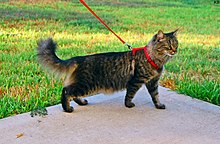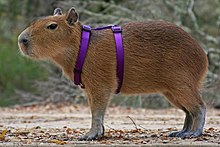Pet harness
This article needs additional citations for verification. (December 2009) |

A pet harness is equipment consisting of straps of webbing that loop nearly around—that fasten together using side release buckles—the torso of an animal.
These harnesses generally are made to have both a strap on the chest in front of the forelimbs, and a strap around the torso behind the forelimbs, with straps in between connecting these two. Having a D-ring suitable for (pet tags and) a leash to clip to, they are most often used to restrain an animal, but dogs also particularly wear them to assist a person with a disability or haul people and items. There is also the lifting harness for dogs with disabilities, covered in this article.
Some come in different sizes, although many are size-adjustable with tri-glide slides to loosen or shorten the straps’ length. The straps may come in a range of different colors, and some have reflective coating.

For physical restraint[]

The most common use of the pet harness is for physically restraining an animal. When used as such, the harness is worn in conjunction with a leash; one end of the leash has a metal clip that is attached to the ring on the harness, while the other end is typically a loop held by the human.
While a collar only encircles the neck, harnesses have loops that surround the thorax. This design allows for the distribution of force, which reduces pressure placed on the animal's trachea, and therefore, possesses a significantly lower risk of strangulation. Harnesses also possess a much lesser chance of said animal slipping out than possible if it wears a collar. As such, collars have largely been replaced by harnesses.

Pet clothing frequently sports a properly-placed buttonhole for the D-ring of the harness worn under the garment.
Some harnesses, such as those worn by police dogs, may have a handle so they can be restrained (or lifted) by hand more securely. Such harness (or vest) may bear identification and have bulletproof padding.

Car safety harnesses[]
Safety harnesses designed for use in an automobile restrain the animal in a car seat using the car's seat belt. These harnesses are marketed as reducing the risk of injury to a pet that is riding in a vehicle during a traffic collision. The harnesses are also said to keep the pet from distracting the driver, or escaping from a vehicle.[1][2] The found "a 100-percent failure rate to protect either the consumer or the dog [or other animal]" in a 2013 crash test study of existing car safety harnesses.[2][3] Since then, several car safety harness have been designed that pass crash tests conducted by the Center for Pet Safety.
Legislation[]
In 2012, New Jersey became the first US state to pass a bill that requires dog and cat owners to restrain their animals while traveling in a moving vehicle. Since the bill's passing, all pets not traveling in a crate and not wearing a safety harness can earn the violator a fine of up to $1,000 and/or six months in prison.[4]
See also[]
References[]
- ^ "Archived copy". Archived from the original on 2011-09-28. Retrieved 2011-09-26.
{{cite web}}: CS1 maint: archived copy as title (link), Car Safety for Canines, Retrieved on 2011-9-26. - ^ a b "Travelling by Car with Pets : The Humane Society of the United States". Humanesociety.org. Retrieved 2012-10-19.
- ^ "Tests On Dog Harnesses Show 100 Percent Failure Rate « CBS Miami". Miami.cbslocal.com. 2013-06-21. Retrieved 2013-09-05.
- ^ Neal, Meghan. "New Jersey says drivers should buckle up their pets, or face a fine". nydailynews.com. Retrieved 5 February 2021.
- Dog sports
- Dog equipment
